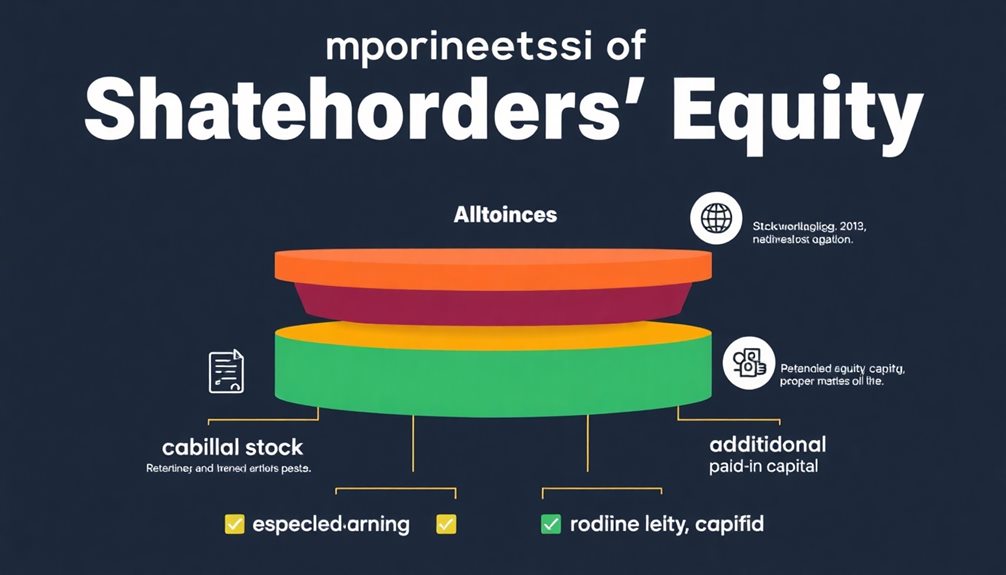Shareholders' equity represents your claim on a company's assets after all debts are settled. It's calculated as total assets minus total liabilities, showing the net worth accessible to shareholders. Positive equity signals financial stability, assuring you that the company can meet its obligations, while negative equity raises red flags about potential insolvency. This metric is essential for evaluating a company's health and investment potential. By examining components like retained earnings and return on equity, you can uncover deeper insights into a company's performance and prospects. More valuable information awaits you to enhance your understanding of this vital financial concept.
Key Takeaways
- Shareholders' equity represents the net worth available to shareholders after debts are settled, calculated as Total Assets minus Total Liabilities.
- Positive equity indicates financial stability, reassuring investors about a company's ability to cover its obligations and absorb losses.
- Negative equity signals potential financial distress, raising concerns about solvency and the company's ability to secure loans or investments.
- Return on Equity (ROE) measures how effectively a company utilizes shareholders' equity to generate profits, influencing investor interest.
- Monitoring retained earnings, a component of equity, reflects a company's growth potential and reinvestment strategies, impacting overall financial health.
Definition of Shareholders' Equity

Shareholders' equity, at its core, represents your claim on a company's assets after all debts are settled. It's calculated by subtracting total liabilities from total assets, giving you a clear picture of net worth. This figure is essential, as it reflects the residual value available to you and other shareholders, especially upon liquidation of the company.
The components of shareholders' equity include common stock, retained earnings, and additional paid-in capital, among others. Each of these elements plays a significant role in determining the overall financial health of the company.
When you see positive equity, it indicates that the company has more assets than liabilities, which is a good sign for potential investors. Conversely, negative equity suggests that the company may face financial distress, raising concerns about its solvency.
Understanding shareholders' equity helps you gauge a company's stability and growth potential. It gives you insight into how well management is utilizing its capital and retaining earnings.
Importance of Shareholders' Equity

Understanding the significance of shareholders' equity is essential for anyone looking to evaluate a company's financial standing. Shareholders' equity represents the owners' residual claim on the company's assets after all liabilities have been settled, indicating its net worth. This metric serves as a critical indicator of financial health, helping you assess a company's stability and growth potential.
Positive equity suggests that the company has sufficient assets to cover its debts, which is a reassuring sign for investors.
Moreover, shareholders' equity plays a key role in calculating return on equity (ROE), a measure of how effectively a company uses its equity to generate profit. An increase in equity often signals profitable operations, illustrating effective reinvestment strategies.
When a company shows strong shareholders' equity, it becomes more attractive to investors, as it reflects cumulative financial progress and the potential for future dividends and capital appreciation.
Calculation Methods

Calculating shareholders' equity is essential for evaluating a company's financial position. You can determine this by using the formula: Shareholders' Equity = Total Assets – Total Liabilities. This straightforward method gives you a clear measure of a company's net worth.
Alternatively, you can use another calculation method: Shareholders' Equity = Common Stock + Preferred Stock + Retained Earnings – Treasury Stock. This highlights the various components that contribute to equity.
To perform these calculations, you'll need to refer to the company's balance sheet, which provides a snapshot of its financial position at a specific time. Total assets include both current assets, like cash and inventory, and non-current assets, such as property and equipment. Meanwhile, total liabilities encompass both current and long-term obligations.
Regularly monitoring shareholders' equity through financial ratios—like the equity ratio (Total Equity / Total Assets)—can offer valuable insights into a company's financial health and stability.
Components of Shareholders' Equity

When you look at shareholders' equity, you'll notice it includes key components like common stock, retained earnings, and preferred stock.
Common stock gives you ownership in the company, while preferred stock offers fixed dividends and priority in liquidation.
Understanding these elements helps you grasp how they influence a company's financial health.
Common Stock Overview
Common stock is an important component of shareholders' equity, representing ownership shares in a company that grant you voting rights and a claim on its assets and earnings. As a common stockholder, you play a significant role in the financial health of the company.
Here are three key aspects to take into account:
- Voting Rights: Holding common stock provides you with the ability to vote on important company matters, influencing decisions such as board elections and major corporate policies.
- Dividends: While dividends can be a source of income, they're not guaranteed. The company's performance and retained earnings will determine if and how much you receive.
- Liquidation Claims: In the unfortunate event of liquidation, common shareholders receive their share of the remaining assets only after all debts and preferred stock obligations are settled, which underscores the risk involved.
The value of common stock fluctuates based on market conditions and company performance, ultimately affecting the market capitalization and total equity.
Your investment in common stock connects you directly to the company's financial journey and potential rewards.
Retained Earnings Significance
Retained earnings serve as an essential component of shareholders' equity, reflecting the profits a company chooses to reinvest in its operations instead of distributing as dividends. This accumulation of cumulative earnings plays a pivotal role in enhancing the company's financial health. By retaining profits, a company can fund future growth without relying on external financing, thereby increasing its total assets over time.
However, retained earnings aren't just a marker of profitability; they also influence the company's balance sheet considerably. Analysts and investors closely monitor this figure, as it can indicate trends in net income and overall sustainability. A decline in retained earnings, due to net losses or dividends paid, can lead to negative shareholder equity, raising concerns among stakeholders.
Here's a simplified view of retained earnings importance:
| Aspect | Explanation |
|---|---|
| Cumulative Earnings | Profits reinvested for growth |
| Impact on Financial Health | Indicator of sustainability and operational success |
| Effects of Dividends Paid | Reduces total retained earnings and equity |
Preferred Stock Characteristics
Preferred stock stands out among the components of shareholders' equity due to its unique blend of characteristics that cater to both income-seeking investors and companies looking for flexible financing options.
When you invest in preferred stock, you gain specific advantages:
- Fixed Dividend Payments: Preferred stock typically offers regular and fixed dividend payments, prioritized over those of common stockholders, guaranteeing a steady income stream.
- Higher Claims on Assets: In the event of liquidation, preferred stockholders have a superior claim on assets compared to common stockholders, which enhances the safety of your investment.
- Cumulative Dividends: If a company misses a dividend payment, cumulative dividends guarantee that you'll receive the owed amounts before any distributions go to common stockholders, reinforcing your financial health.
However, keep in mind that preferred stock usually comes without voting rights, limiting your influence on corporate governance.
Additionally, many preferred stocks offer conversion options, allowing you to convert your shares into common stock, which could be beneficial if the company's value increases.
Positive vs. Negative Equity

Understanding the difference between positive and negative equity is essential for evaluating a company's financial health. Positive shareholders' equity occurs when a company's total assets exceed its total liabilities, indicating financial stability and a sound capital structure. This situation often reassures investors about a company's operational and financial health, highlighting its long-term viability.
Conversely, negative shareholders' equity arises when liabilities exceed assets, which can signal potential insolvency or financial distress. Companies with persistent negative equity might struggle to secure loans or attract investors, as it raises concerns about their ability to navigate future challenges.
For instance, firms that have sustained long-term losses or that distribute excessive dividends beyond their earnings often find themselves in this predicament.
Investors view companies with negative equity as a significant risk factor. They typically conduct a deeper analysis of these firms before considering investment, focusing on the underlying issues that led to such a situation.
Ultimately, understanding these concepts will help you make more informed decisions regarding investments and assess a company's overall financial health effectively.
Impact on Financial Health

Understanding shareholders' equity is essential for evaluating a company's financial health.
When you see positive equity, it often signals that the company can cover its liabilities, making it more appealing to investors.
On the other hand, negative equity can raise red flags about potential risks, influencing your investment decisions considerably.
Positive Equity Indicators
Positive equity indicators play an essential role in evaluating a company's financial health. When you see positive shareholders' equity, it indicates that a company has more assets than liabilities, reflecting strong financial stability and a solid balance sheet.
This positive equity not only reduces the insolvency risk but also enhances the company's ability to attract investments, similar to how risk management strategies can mitigate potential losses in volatile markets.
Here are three key benefits of positive equity indicators:
- Retained Earnings: These represent profits reinvested into the business, fueling future growth and operational expansion.
- Investment Attraction: Companies with positive equity are viewed favorably by investors, showcasing a lower risk of insolvency and a greater ability to absorb losses.
- Profit Generation: A consistent increase in shareholders' equity signals effective resource management and robust financial health, reassuring stakeholders about the company's profitability.
Negative Equity Risks
Negative shareholders' equity can serve as a warning light on a company's financial dashboard. It occurs when total liabilities exceed total assets, indicating potential insolvency and financial distress. If you see persistent negative equity, it might signal ongoing operational losses, excessive dividend payments, or aggressive share buyback programs, all of which can point to poor financial management.
When a company has negative equity, it faces significant challenges in securing loans or attracting investment. Investors will likely raise concerns about the company's ability to meet its obligations and sustain operations. This diminished confidence can lead to decreased stock prices, further exacerbating financial difficulties.
Historical examples illustrate the risks of sustained negative equity, showing how some companies have entered bankruptcy as a result. Maintaining a positive equity position is critical for long-term stability and growth.
If you're considering investing in a company, be wary of negative shareholders' equity, as it may indicate deeper financial issues. Ultimately, understanding these risks can help you make better-informed decisions regarding your investments and protect your financial health.
Investment Decision Influence
When evaluating a company's financial health, shareholders' equity plays a vital role in shaping your investment decisions. This figure represents the net worth of a company after settling liabilities and is essential for gauging stability and growth potential.
Here are three key aspects to take into account:
- Positive Shareholders' Equity: A positive figure suggests the company has enough assets to cover its obligations, enhancing its attractiveness to investors.
- Return on Equity (ROE): Calculating ROE using net income divided by shareholders' equity helps you determine how efficiently a company is using its equity to generate profits. A higher ROE often signals better profitability trends.
- Retained Earnings: Changes in retained earnings reflect a company's reinvestment strategies and overall profitability trends, significant for forecasting potential returns.
Conversely, negative shareholders' equity can indicate financial distress, suggesting the company owes more than it owns. This situation poses higher risks, which could discourage your investment decisions.
Return on Equity (ROE)

Return on Equity (ROE) serves as a crucial indicator of how effectively a company utilizes shareholders' equity to generate profits. You calculate ROE by dividing net income by shareholders' equity. This metric reflects a company's profitability and its ability to turn equity capital into earnings.
A consistent ROE suggests effective management strategies and a commitment to reinvestment, signaling growth potential.
Investors generally favor higher ROE values, as they indicate a more efficient use of equity capital. For example, a 15% ROE means the company earns $0.15 for every dollar of equity.
Analyzing trends in ROE over multiple years can provide critical insights into a company's financial performance and operational efficiency, helping you make informed investment decisions.
Companies boasting a ROE above the industry average often attract more attention from shareholders, as they typically possess a competitive advantage in generating returns on equity investments.
By understanding ROE, you can better assess a company's ability to deliver value and profitability, ultimately guiding your investment choices.
Keep ROE in mind as you evaluate potential opportunities in the market.
Real-World Examples

Real-world examples of shareholders' equity provide valuable insights into how companies manage their financial health and growth potential. Consider these key instances:
- PepsiCo: As of Q1 2024, PepsiCo reported shareholders' equity of $19.19 billion, an 11.73% year-over-year increase. This growth indicates strong financial performance and investor confidence.
- Coca-Cola: For the same period, Coca-Cola's shareholders' equity was $27.946 billion, reflecting a 4.01% increase. This stability in a competitive industry showcases a healthy balance sheet, reassuring investors.
- Hypothetical ABC Company: With total assets of $2.6 million and total liabilities of $920,000, ABC Company boasts shareholders' equity of $1.68 million. This example illustrates how a positive equity figure can indicate a robust financial position.
Investors often look for signs of growth in retained earnings, particularly among tech companies, as this can lead to rising stock prices.
However, keep an eye out for negative shareholders' equity, as it can signal severe financial distress and potential bankruptcy risks. Understanding these examples helps you gauge a company's overall financial health.
Evaluating Shareholders' Equity

Evaluating shareholders' equity is essential for understanding a company's financial health. You can calculate shareholders' equity using the formula: Total Assets minus Total Liabilities. A positive result indicates financial stability, showing that a company possesses more assets than liabilities. Conversely, negative equity can signify potential insolvency, raising concerns for investors.
One key component of shareholders' equity is retained earnings, which represent profits reinvested in the business. By focusing on retained earnings, you can assess the company's growth potential and commitment to long-term success.
The equity ratio, determined by dividing Total Equity by Total Assets, offers insights into a company's capital structure. A higher ratio typically indicates less reliance on debt, enhancing perceived financial stability.
Monitoring changes in shareholders' equity over time reveals vital details about a company's operational efficiency and profitability trends. Consistent growth in equity suggests strong management performance and a positive business outlook.
Frequently Asked Questions
What Does Shareholders Equity Tell You?
Shareholders' equity tells you about a company's financial health. It shows how much value shareholders have after debts are paid off. Positive equity means stability, while negative equity raises concerns about potential risks and insolvency.
What Is a Good Shareholder Equity Ratio?
A good shareholders' equity ratio typically falls between 20% to 50%. This range shows a solid balance between debt and equity, indicating financial stability and lower risk, making it more attractive to potential investors.
What Is the Equity of a Company's Shareholders?
The equity of a company's shareholders represents their claim on assets after all liabilities are settled. It reflects the company's financial health and is essential for understanding investment potential and overall stability.
How Important Is Shareholder Equity?
Shareholder equity's essential for evaluating a company's financial health. It shows how well a business manages its assets and liabilities, impacting investment decisions and reflecting growth potential. You should always consider it when assessing a company's performance.
Conclusion
In summary, understanding shareholders' equity is essential for evaluating a company's financial health. It's the backbone of your investment decisions, revealing how much value you truly own. Remember, "a penny saved is a penny earned"—the same applies here. By analyzing equity, you can spot potential growth and risks, ensuring you make informed choices. So, keep an eye on those numbers; they tell the story of your investment's future!










